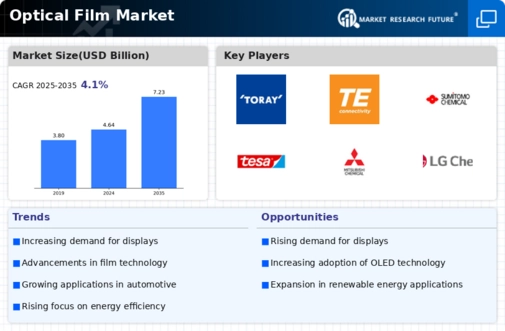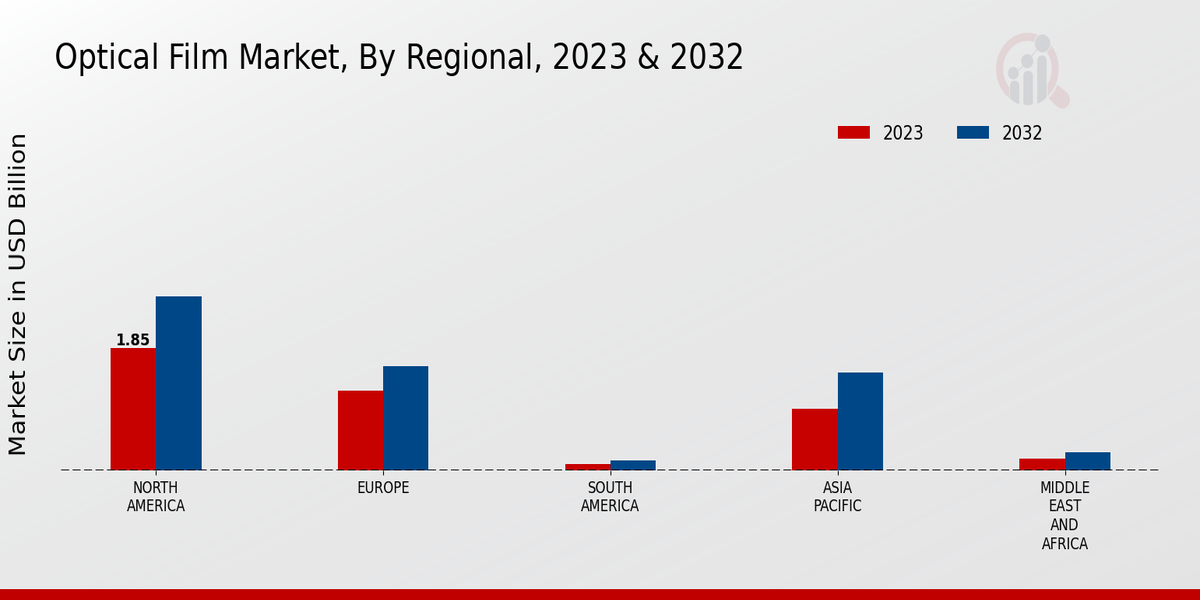Market Growth Projections
The Global Optical Film Market Industry is projected to experience substantial growth over the next decade. With an expected market value of 4.64 USD Billion in 2024, the industry is on track to reach 7.23 USD Billion by 2035. This growth trajectory indicates a compound annual growth rate of 4.12% from 2025 to 2035. Such projections reflect the increasing integration of optical films in various applications, including consumer electronics, automotive, and lighting. The anticipated growth underscores the importance of optical films in enhancing performance and efficiency across multiple sectors.
Expansion of the LED Lighting Sector
The expansion of the LED lighting sector significantly influences the Global Optical Film Market Industry. Optical films are integral to LED lighting solutions, enhancing light distribution and efficiency. As the global shift towards energy-efficient lighting solutions accelerates, the demand for optical films is expected to rise. This trend aligns with sustainability initiatives and government regulations promoting energy conservation. The market's growth is further supported by the anticipated compound annual growth rate of 4.12% from 2025 to 2035, indicating a robust future for optical films in the lighting industry. Manufacturers are likely to capitalize on this momentum to innovate and expand their product offerings.
Increasing Focus on Energy Efficiency
The Global Optical Film Market Industry is increasingly influenced by a growing emphasis on energy efficiency across various sectors. As industries and consumers alike prioritize sustainability, the demand for optical films that enhance energy performance becomes paramount. These films contribute to reduced energy consumption in displays and lighting applications, aligning with global efforts to minimize carbon footprints. The market's trajectory suggests that manufacturers will continue to innovate in this area, developing films that not only meet performance standards but also adhere to environmental regulations. This focus on energy efficiency is likely to drive market growth in the coming years.
Rising Demand for Consumer Electronics
The Global Optical Film Market Industry experiences a notable surge in demand driven by the proliferation of consumer electronics. Devices such as smartphones, tablets, and televisions increasingly incorporate advanced optical films to enhance display quality. The market is projected to reach 4.64 USD Billion in 2024, reflecting a growing consumer preference for high-definition displays. As manufacturers strive to meet these expectations, the integration of optical films becomes essential for improving brightness, contrast, and energy efficiency. This trend suggests a robust growth trajectory for the industry, as the demand for superior visual experiences continues to escalate.
Growing Adoption in Automotive Applications
The Global Optical Film Market Industry is witnessing increased adoption of optical films in automotive applications. As vehicles become more technologically advanced, the integration of optical films in displays, head-up displays, and infotainment systems enhances user experience and safety. This trend is driven by consumer demand for sophisticated features and improved aesthetics. The automotive sector's shift towards electric and autonomous vehicles further amplifies the need for high-quality optical films. Consequently, the market is poised for growth, as automotive manufacturers prioritize advanced display technologies to meet evolving consumer expectations.
Technological Advancements in Display Technologies
Technological innovations play a pivotal role in shaping the Global Optical Film Market Industry. The advent of new display technologies, such as OLED and QLED, necessitates the use of specialized optical films to optimize performance. These advancements not only enhance image quality but also improve energy efficiency, aligning with global sustainability goals. As the industry evolves, manufacturers are likely to invest in research and development to create films that cater to these emerging technologies. This focus on innovation indicates a promising future for the market, with expectations of reaching 7.23 USD Billion by 2035.








